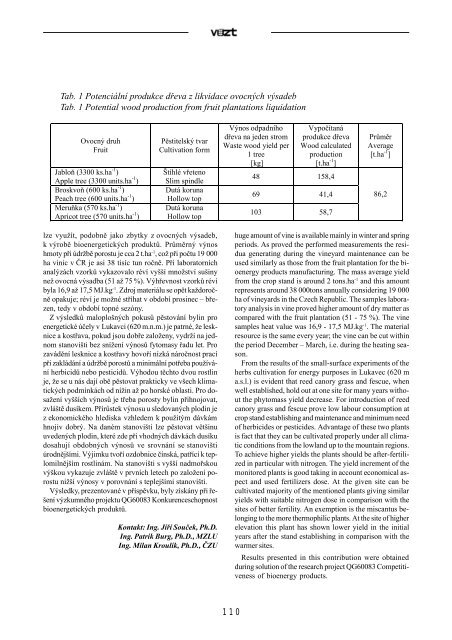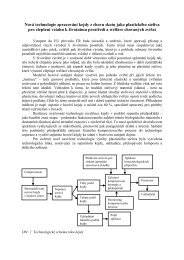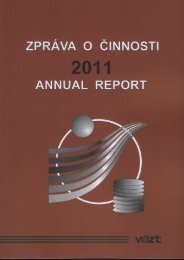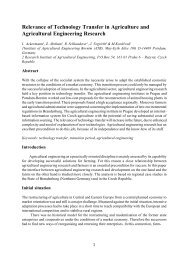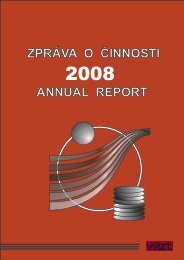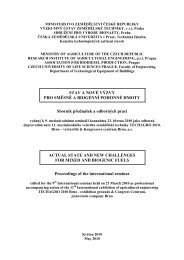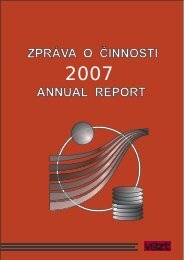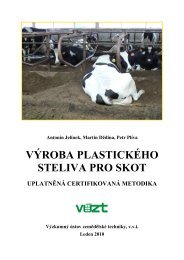Zpráva o ÄÂinnosti v roce 2006 (10MB) - SVT
Zpráva o ÄÂinnosti v roce 2006 (10MB) - SVT
Zpráva o ÄÂinnosti v roce 2006 (10MB) - SVT
You also want an ePaper? Increase the reach of your titles
YUMPU automatically turns print PDFs into web optimized ePapers that Google loves.
Tab. 1 Potenciální produkce døeva z likvidace ovocných výsadeb<br />
Tab. 1 Potential wood production from fruit plantations liquidation<br />
Ovocný druh<br />
Fruit<br />
Jabloò (3300 ks.ha -1 )<br />
Apple tree (3300 units.ha -1 )<br />
Broskvoò (600 ks.ha -1 )<br />
Peach tree (600 units.ha -1 )<br />
Meruòka (570 ks.ha -1 )<br />
Apricot tree (570 units.ha -1 )<br />
Pìstitelský tvar<br />
Cultivation form<br />
Štíhlé vøeteno<br />
Slim spindle<br />
Dutá koruna<br />
Hollow top<br />
Dutá koruna<br />
Hollow top<br />
Výnos odpadního<br />
døeva na jeden strom<br />
Waste wood yield per<br />
1 tree<br />
[kg]<br />
Vypoèítaná<br />
produkce døeva<br />
Wood calculated<br />
production<br />
[t.ha -1 ]<br />
48 158,4<br />
69 41,4<br />
103 58,7<br />
Prùmìr<br />
Average<br />
[t.ha -1 ]<br />
86,2<br />
lze využít, podobnì jako zbytky z ovocných výsadeb,<br />
k výrobì bioenergetických produktù. Prùmìrný výnos<br />
hmoty pøi údržbì porostu je cca 2 t.ha -1 , což pøi poètu 19 000<br />
ha vinic v ÈR je asi 38 tisíc tun roènì. Pøi laboratorních<br />
analýzách vzorkù vykazovalo réví vyšší množství sušiny<br />
než ovocná výsadba (51 až 75 %). Výhøevnost vzorkù réví<br />
byla 16,9 až 17,5 MJ.kg -1 . Zdroj materiálu se opìt každoroènì<br />
opakuje; réví je možné støíhat v období prosinec – bøezen,<br />
tedy v období topné sezóny.<br />
Z výsledkù maloplošných pokusù pìstování bylin pro<br />
energetické úèely v Lukavci (620 m.n.m.) je patrné, že lesknice<br />
a kostøava, pokud jsou dobøe založeny, vydrží na jednom<br />
stanovišti bez snížení výnosù fytomasy øadu let. Pro<br />
zavádìní lesknice a kostøavy hovoøí nízká nároènost prací<br />
pøi zakládání a údržbì porostù a minimální potøeba používání<br />
herbicidù nebo pesticidù. Výhodou tìchto dvou rostlin<br />
je, že se u nás dají obì pìstovat prakticky ve všech klimatických<br />
podmínkách od nížin až po horské oblasti. Pro dosažení<br />
vyšších výnosù je tøeba porosty bylin pøihnojovat,<br />
zvláštì dusíkem. Pøírùstek výnosu u sledovaných plodin je<br />
z ekonomického hlediska vzhledem k použitým dávkám<br />
hnojiv dobrý. Na daném stanovišti lze pìstovat vìtšinu<br />
uvedených plodin, které zde pøi vhodných dávkách dusíku<br />
dosahují obdobných výnosù ve srovnání se stanovišti<br />
úrodnìjšími. Výjimku tvoøí ozdobnice èínská, patøící k teplomilnìjším<br />
rostlinám. Na stanovišti s vyšší nadmoøskou<br />
výškou vykazuje zvláštì v prvních letech po založení porostu<br />
nižší výnosy v porovnání s teplejšími stanovišti.<br />
Výsledky, prezentované v pøíspìvku, byly získány pøi øešení<br />
výzkumného projektu QG60083 Konkurenceschopnost<br />
bioenergetických produktù.<br />
Kontakt: Ing. Jiøí Souèek, Ph.D.<br />
Ing. Patrik Burg, Ph.D., MZLU<br />
Ing. Milan Kroulík, Ph.D., ÈZU<br />
huge amount of vine is available mainly in winter and spring<br />
periods. As proved the performed measurements the residua<br />
generating during the vineyard maintenance can be<br />
used similarly as those from the fruit plantation for the bioenergy<br />
products manufacturing. The mass average yield<br />
from the crop stand is around 2 tons.ha -1 and this amount<br />
represents around 38 000tons annually considering 19 000<br />
ha of vineyards in the Czech Republic. The samples laboratory<br />
analysis in vine proved higher amount of dry matter as<br />
compared with the fruit plantation (51 - 75 %). The vine<br />
samples heat value was 16,9 - 17,5 MJ.kg -1 . The material<br />
resource is the same every year; the vine can be cut within<br />
the period December – March, i.e. during the heating season.<br />
From the results of the small-surface experiments of the<br />
herbs cultivation for energy purposes in Lukavec (620 m<br />
a.s.l.) is evident that reed canory grass and fescue, when<br />
well established, hold out at one site for many years without<br />
the phytomass yield decrease. For introduction of reed<br />
canory grass and fescue prove low labour consumption at<br />
crop stand establishing and maintenance and minimum need<br />
of herbicides or pesticides. Advantage of these two plants<br />
is fact that they can be cultivated properly under all climatic<br />
conditions from the lowland up to the mountain regions.<br />
To achieve higher yields the plants should be after-fertilized<br />
in particular with nitrogen. The yield increment of the<br />
monitored plants is good taking in account economical aspect<br />
and used fertilizers dose. At the given site can be<br />
cultivated majority of the mentioned plants giving similar<br />
yields with suitable nitrogen dose in comparison with the<br />
sites of better fertility. An exemption is the miscantus belonging<br />
to the more thermophilic plants. At the site of higher<br />
elevation this plant has shown lower yield in the initial<br />
years after the stand establishing in comparison with the<br />
warmer sites.<br />
Results presented in this contribution were obtained<br />
during solution of the research project QG60083 Competitiveness<br />
of bioenergy products.<br />
110


